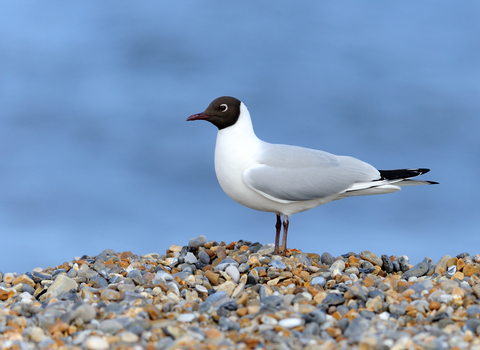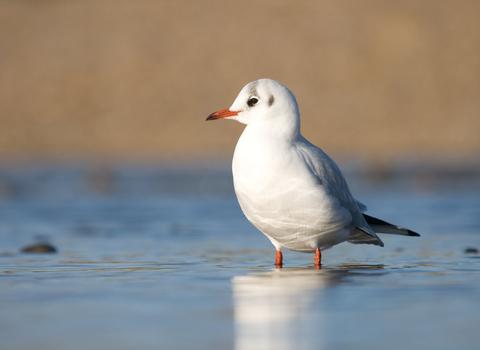
Black-headed gull (summer) ©Amy Lewis

Black-headed gull (winter) ©Tom Marshall
Black-headed gull
The black-headed gull is actually a chocolate-brown headed gull! And for much of the year, it's head even turns white. Look out for it in large, noisy flocks on a variety of habitats.
Scientific name
Chroicocephalus ridibundusWhen to see
January to DecemberSpecies information
Category
Statistics
Length: 35-38cmWingspan: 100-110cm
Weight: 200-400g
Average lifespan: 11-13 years but can live up to 30
Classified in the UK as Amber under the Birds of Conservation Concern 5: the Red List for Birds (2021).
About
The black-headed gull is a familiar sight on farmland, wetland and coastal habitats throughout the UK. It nests on saltmarshes and on islands in flooded gravel pits and reservoirs, and sometimes forms very large, noisy colonies. There are about 140,000 breeding pairs in the UK and about 2.2 million wintering birds each year.How to identify
The black-headed gull is our commonest small gull. During summer, it actually has a chocolate-brown head, rather than a jet-black one, which turns white for the rest of the year, with little black ruminant spots on either side of the head, which make it look like the bird is wearing headphones. It is silvery-grey above and white below, black wingtips. It has red legs and a red bill, which become darker in summer.Distribution
Widespread.In our area
Large numbers of these characterful birds gather on open water at dusk. Places to look out for them are Priorslee Flash in Telford, Chelmarsh near Bridgnorth and at Wood Lane nature reserve near Ellesmere.
Did you know?
The species-specific part of the black-headed gull's Latin name, Chroicocephalus ridibundus, means 'laughing ' and comes from its 'ke-ke-ke' and 'kverarrr' calls.Large numbers of these characterful birds gather on open water at dusk. Places to look out for them are Priorslee Flash in Telford, Chelmarsh near Bridgnorth and at Wood Lane nature reserve near Ellesmere.

